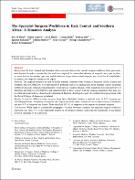| dc.contributor.author | O’Flynn, Eric | |
| dc.contributor.author | Andrew, Judith | |
| dc.contributor.author | Hutch, Avril | |
| dc.contributor.author | Kelly, Caitrin | |
| dc.contributor.author | Jani, Pankaj | |
| dc.contributor.author | Kakande, Ignatius | |
| dc.contributor.author | Derbew, Miliard | |
| dc.contributor.author | Tierney, Sean | |
| dc.contributor.author | Mkandawire, Nyengo | |
| dc.contributor.author | Erzingatsian, Krikor | |
| dc.date.accessioned | 2021-04-21T08:53:09Z | |
| dc.date.available | 2021-04-21T08:53:09Z | |
| dc.date.issued | 2016-01-01 | |
| dc.identifier.citation | O’Flynn, E., Andrew, J., Hutch, A., Kelly, C., Jani, P., Kakande, I., Derbew, M., Tierney, S., Mkandawire, N. and Erzingatsian, K., 2016. The specialist surgeon workforce in east, central and southern Africa: a situation analysis. World journal of surgery, 40(11), pp.2620-2627. | en_US |
| dc.identifier.issn | 0364-2313 | |
| dc.identifier.issn | 1432-2323 | |
| dc.identifier.uri | http://hdl.handle.net/20.500.12280/2676 | |
| dc.description.abstract | Background In East, Central and Southern Africa accurate data on the current surgeon workforce have previously been limited. In order to ensure that the workforce required for sustainable delivery of surgical care is put in place, accurate data on the number, specialty and distribution of specialist-trained surgeons are crucial for all stakeholders in surgery and surgical training in the region.
Methods The surgical workforce in each of the ten member countries of the College of Surgeons of East, Central and Southern Africa (COSECSA) was determined by gathering and crosschecking data from multiple sources including COSECSA records, medical council registers, local surgical societies records, event attendance lists and interviews of Members and Fellows of COSECSA, and validating this by direct contact with the surgeons identified. This data was recorded and analysed in a cloud-based computerised database, developed as part of a collaboration programme with the Royal College of Surgeons in Ireland.
Results A total of 1690 practising surgeons have been identified yielding a regional ratio of 0.53 surgeons per 100,000 population. A majority of surgeons (64 %) practise in the main commercial city of their country of residence and just 9 % of surgeons are female. More than half (53 %) of surgeons in the region are general surgeons.
Conclusions While there is considerable geographic variation between countries, the regional surgical workforce represents less than 4 % of the equivalent number in developed countries indicating the magnitude of the human resource challenge to be addressed. | en_US |
| dc.language.iso | en | en_US |
| dc.publisher | Springer | en_US |
| dc.relation.ispartofseries | World journal of surgery;40(11) | |
| dc.subject | Specialist surgeon | en_US |
| dc.subject | Workforce | en_US |
| dc.subject | East, Central and Southern Africa | en_US |
| dc.subject | Analysis | en_US |
| dc.title | The Specialist Surgeon Workforce in East, Central and Southern Africa: A Situation Analysis | en_US |
| dc.type | Article | en_US |


